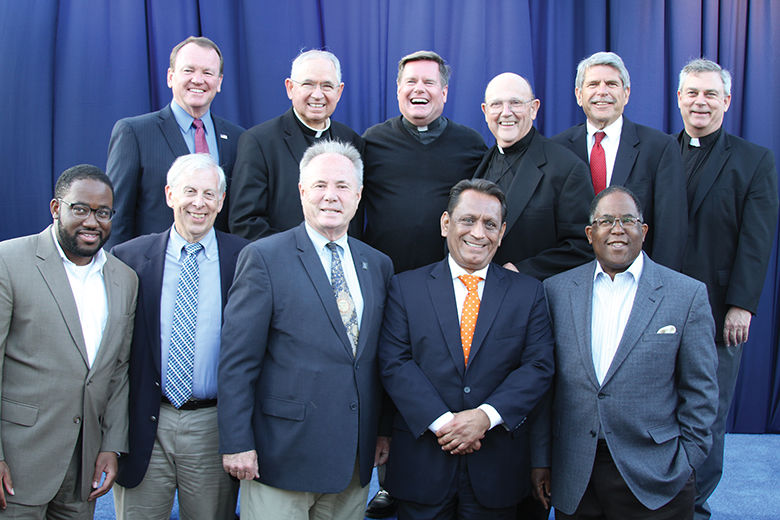Commemorating 150 years as the oldest continually operating educational institution in Southern California, Loyola High School of Los Angeles’ yearlong sesquicentennial celebration culminated May 30.
Archbishop José H. Gomez gave an in-person blessing to the Loyola community during the daylong festival celebrating Loyola’s rich history in Los Angeles. More than 4,000 students, alumni, parents, benefactors and prospective students attended the “Cub Fest” event.
As Archbishop Gomez addressed the crowd, he touched on the power of education and how it shapes communities. He noted that “education is an act of love that gives life to the children to grow and lead the community.”
Loyola High School has been celebrating its 150-year history since November.
“I think everyone in the Loyola community is very pleased. The celebration began with a football game at home — the first football game at home in 65 years,” said sesquicentennial chair Jack Girardi.
“We had the day of service with over a 1,000 volunteers throughout Southern California involved in projects and then today we have something in the range of 4,000 people that were able to come to Cub Fest.”
At the time of Loyola’s founding in 1865, Los Angeles was a cattle town much like the rest of the Wild West. Loyola, originally St. Vincent’s College, was founded by the order of the Vincentians. St. Vincent’s College rented rooms from the Lugo Adobe for classes.
Built by Don Vicente Lugo, the Lugo Adobe was one of the very few two-story houses in the pueblo of Los Angeles. The school quickly established and relocated to Hill and Broadway in Downtown Los Angeles and moved again in 1887 to Washington and Grand.
In 1903, St. Vincent’s College had nearly 200 students. Records show that students came from all across the country, including New York, Texas, Arizona, Montana and even Mexico.
“The Vincentians brought education to Los Angeles,” said Father Bill Piletic, CM.
In 1915, the Jesuits took over control of the school when the Vincentian order wanted to return to educating seminarians and helping the poor. The name of St. Vincent’s College changed to Loyola College of Los Angeles in 1918 when construction of the present day Loyola High School campus began on Venice Boulevard.
Loyola College later moved to where present day Loyola Marymount University resides on the Del Rey mesa. In 1930, Loyola High School received a charter from the state of California officially recognizing it as a high school.
From Loyola’s Vincentian and Jesuit roots, “educating the whole person” and “men for others” have always been Loyola’s most sacred philosophies. Frank Kozakowski, principal of Loyola High School, says today’s graduates are no different than in the past.
“We educate young men that are going to be the leaders in the community for the greater good and to help the poor and the marginalized,” he said.
Dignitaries including Assemblyman Sebastian Ridley-Thomas, Honorable Zev Yaroslasky, Supervisor Mark Ridley-Thomas, Sheriff Jim McDonnell, Councilman Tom LaBonge and Councilman Gil Cedillo all gave Loyola High School resolutions commemorating the school’s 150 year anniversary during Cub Fest.
“It has prepared me immeasurably for the future. I learned strong morals, discipline, faith and tradition. I have a deep compassion for human life,” said Assemblyman Sebastian Ridley-Thomas, class of 2005.
Many of Loyola’s alumni are today’s leaders in Los Angeles and throughout Southern California. Loyola has since its beginnings produced a myriad of successful businessmen, doctors, lawyers, journalists, educators and priests, to name a few professions.
Some Loyola graduates — such as Rosecrans, Dockweiler and Amestoy — even have streets named after them in Southern California.
“The students who come out of the school are best prepared for humanity. They have something extra special,” said Honorable Zev Yaroslasky.
Father Gregory Goethals, SJ, who has been president for the past 10 years, says the Loyola community is made up all types of students from all walks of life.
“We are a community that teaches in all zip codes. We have students from as far away as Riverside, Newport Beach and Ventura County along with from our own Pico-Union neighborhood,” he said.
Currently, the student body is preparing for finals and graduation. They are looking toward the future. Father Goethals is preparing for the school’s future while respecting the past.
“I want to have permanent financial support to be able to support all of our students as tuition rises. Every school gets more expensive every year for a number of reasons,” Father Goethals said.
“Education is an expensive prospect. I want to make sure we can offset the rise of tuition and make sure we have all of the resources we need to do all of the things we want to do.”
For more information on Loyola High School’s 150th Anniversary, read California State Historian, Dr. Kevin Starr’s book: “LHS: A Sesquicentnial History” or go to www.youtube/watch?v=TnU-P_oyDVD&feature=youtu.be to see Father Goethals give the Opening Prayer

